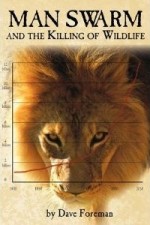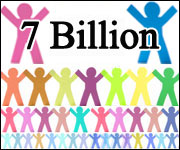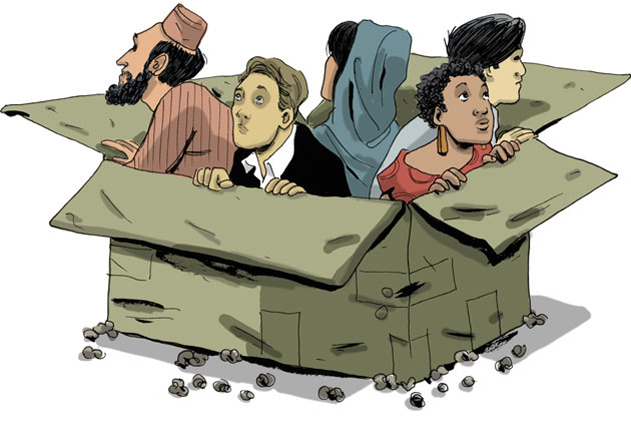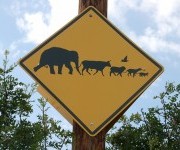Let’s leave some room for everybody else. Photo: Robin PittmanMore of our kind means fewer wild things. A stabilized human population means hope for wild things. A shrinking human population means a better world for wild things — and for men and women and children.
It’s that straightforward.
The human population grew more in the last 40 years than in the previous 3 million. The population bomb has blown up — but the shrapnel hasn’t yet hit us hard. What it has hit hard are wild things.
The outcomes of humanity’s growth yesterday, today, and tomorrow are scalped wildlands, endangered and extinct wildlife, and sweeping climatic upset. Since 1700, the amount of cultivated land on the planet has increased from 7 to 40 percent, according to researchers at the University of Wisconsin-Madison. Spin a globe. More than a third of what you see that is not water or ice has gone from neighborhoods for wildlife to croplands for humans or grazing lands for our livestock.
The mind-numbing, heart-breaking wreckage of the wild is the main driver for the extinction of heaps of other beings worldwide. When Americans shove new houses, yards, and streets into wildlands, we hear more and more bleats to “control” cougars, coyotes, and other wildlife that were living there long before exurban apes thronged in. Fish and Game Departments seem only too happy to squeeze their trigger fingers to rid a new suburb of threatening wild things, even though the wild things were there first. Likewise, in India, Bangladesh, Sumatra, and elsewhere in Asia, when booming crowds overrun wildlands, clashes with tigers and elephants ensue and big cats and tuskers die.
Whether it’s starter castles strung along wide freeways farther away from cities and workplaces in the United States, or new slash-and-burn crop patches and logging roads in third-world countries, we fracture wildlands and throw up barriers that box wild animals into smaller and smaller lots. This leaves animals unable to migrate toward the poles or higher elevations as their home ranges shift because of climate breakdown.
 Read more from Foreman in his new book Man Swarm and the Killing of Wildlife.The shape or siting of a new settlement is often more deadly than how many acres are cleared. A few settlers or “estates” with a handful of roads can stomp down a footprint that breaks up a big wildland. More people here and there leads to more blacktop roads in between, with curves straightened out for faster driving and thereby made more deadly for the lynx or elk used to wandering over a once-slow dirt road.
Read more from Foreman in his new book Man Swarm and the Killing of Wildlife.The shape or siting of a new settlement is often more deadly than how many acres are cleared. A few settlers or “estates” with a handful of roads can stomp down a footprint that breaks up a big wildland. More people here and there leads to more blacktop roads in between, with curves straightened out for faster driving and thereby made more deadly for the lynx or elk used to wandering over a once-slow dirt road.
One way to tell what kinds of wild animals are around is to look at roadkill. The hopeful spread of wolves and cougars in the United States is shown but also stopped by deaths along interstate highways and other main roads. More Coloradans, say, means more cars and pickups and SUVs, which means more upgraded roads, which means death traps for wildlife.
Human crowding and spreading plays hob with ecological and evolutionary processes. More and more of us squeeze into lush, rank river bottoms and thereby make a “need” for upstream flood-control dams, which then stop healthy hydrological processes. More of us need water for irrigating crops and making electricity, both of which call for Brobdingnagian dams on rivers. In the United States and Canada, the spread of homes into forests leads to putting down natural wildfires; stopping such lightning-sparked fires harms forest health and sets up the woods for bigger, unhealthy, unquenchable blazes later. When we take over wildlands, we often make the land unfriendly to native pollinators. And the spread of Homo sapiens onto new lands — whether as suburbanites, city dwellers, or peasants — brings with it careless spilling of pesticides, motor oil, antifreeze, and other nasty crud.
I know well that human numbers will go down. But I don’t know if our swarm will become smaller thanks to our work — birth control — or owing to overshooting our carrying capacity — death control.
 Read more on population. Check out our series 7 billion: What to expect when you’re expanding.Much of what we need to do to slow population growth is not hard. We have the tools; we have the skills. We have steeply cut the birthrate in many lands, climes, and times, and have seen wins in slowing, freezing, and nudging back population growth. We need to keep doing what we have done with family planning and population education, but do more of it in more lands, and give it new thrust of burning need. It is not hard; it only needs will.
Read more on population. Check out our series 7 billion: What to expect when you’re expanding.Much of what we need to do to slow population growth is not hard. We have the tools; we have the skills. We have steeply cut the birthrate in many lands, climes, and times, and have seen wins in slowing, freezing, and nudging back population growth. We need to keep doing what we have done with family planning and population education, but do more of it in more lands, and give it new thrust of burning need. It is not hard; it only needs will.
I won’t tell you that we will win this fight. I will tell you, though, that we can’t win this fight if we don’t take it on. Let us not be blamed by those who come after us for not trying to bring ourselves down to within a carrying capacity that leaves room for everyone else.
This post is adapted from the new book Man Swarm and the Killing of Wildlife.



